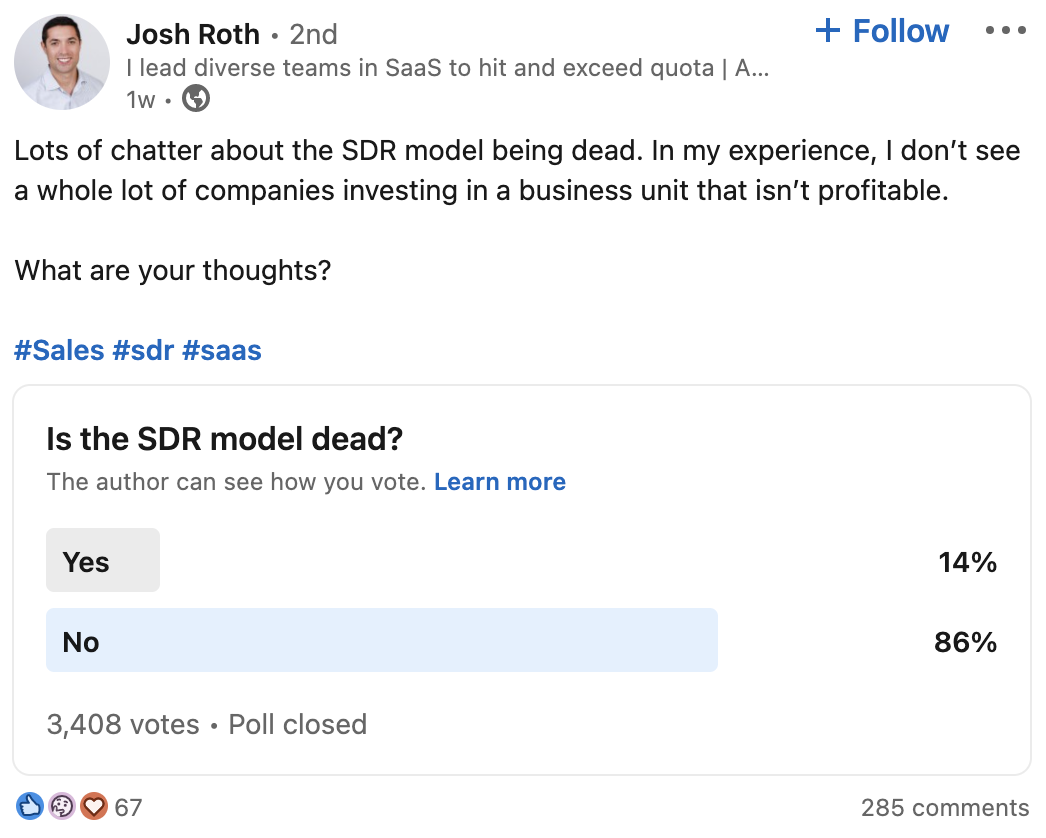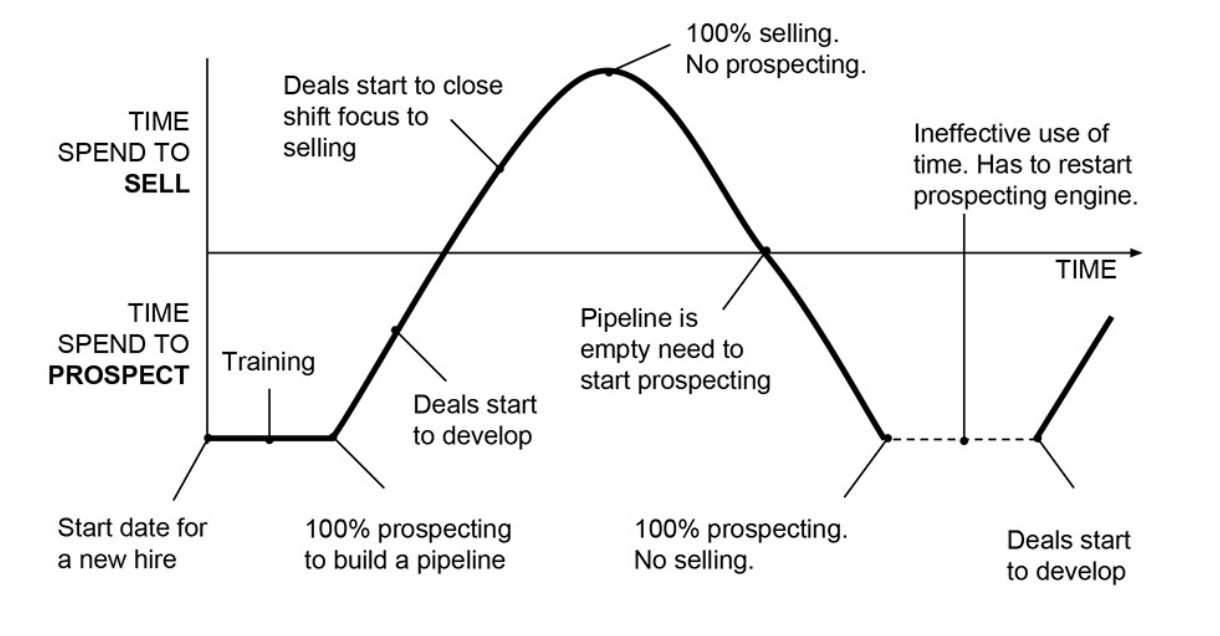By Zihan Wang
A few weeks ago, I read through the threads in this tweet and found myself nodding my head in vigorous agreement.

The question arises whether the Sales Development Representative (SDR) model is dead or not? As did the majority, I voted “No”. I believe the model could be powerful, but it doesn’t work for every business. For this to work in today’s complex and varied sales environments, it needs to evolve. But first things first, let’s understand how it came into play.
💵 More time for sales — why the SDR model made sense
SDRs take over prospecting so that salespeople can focus on selling as opposed to doing both at the same time.
Just as any other kind of specialization, the model was invented to kill inefficiency and drive more stable outcomes. Before the SDR model, salespeople had two significant challenges:
1) Struggle to balance prospecting and sales, resulting in inefficient use of time to reload the prospecting engine, as illustrated in the graph below from the book Sales as a Science.
2) “Hero to Zero” — Fluctuation of performance from hitting the target to missing it by fifty per cent due to the reload.

Now the challenges are laid out from each individual’s perspective, but the real question is, how do these challenges impact the overall performance of a sales team? How does sales productivity as a team vary with and without the SDR model? If you are interested in finding out more about this, drop a comment below and we’ll follow up on this topic in another post.
💀 The modern buying process that drives the SDR model obsolete
Nelson Gilliat, Author of Death of the SDR: Birth of Buyer Centric Revenue, once said:
“A lot of companies don’t realize how harmful SDRs/prospecting (i.e., worst kind of marketing by annoying buyers with telemarketing, email spam, LinkedIn spam) is until they compare the costs/results of it vs proper marketing/demand gen (good, modern marketing).”
It manifests two correlated factors that may drive the SDR model obsolete:
1) Digital revolution led by the internet and social media. 2) The way buyers want to be marketed. We are at a time in which buyers have way more access to the products or services that you are selling than they used to pre-internet. A great portion of these buyers would prefer to go through a self-service process in which they research, narrow down their choices, test out the products and explicitly request “sales help” if they see the relevance. SDRs are thus driven out of the process as their task is to qualify leads and raise interest, both jobs are being done by the modern buyers themselves.
🤦♀️ Why is the SDR model flawed in today’s sales environment?
Starting with cost, which typically includes tooling (CRM, Sales Engagement Tool, Data Provider), SDR manager salary, SDR salary, Sales ops, recruiting, training and overhead. Predictable Revenue did the math and it turns out that an SDR will cost approximately $108K per year. Here is the breakdown of how much each role costs:

Now whether it’s money well-spent depends on the ROI which is highly individual depending on the business. A good indicator is, however, if your cost of the SDR, AE, and Onboarder, also known as the sales POD exceed 40% of the annual on target earning (OTE), you may have to change your go-to-market strategy. More on how to model your sales POD to drive maximum efficiency in this article by Sales Hacker.
The effectiveness perspective is worth investigating as well. A study from the Bridge Group tracked the number of meetings booked by an Account Executive (AE) when they had and didn’t have SDR support. The ones who are supported by SDR reported “only 0.8 more demos per week, on average.” The study was published in 2017 and things may have changed for better or worse now, but the point is there are some important questions that need to be asked:
- What would happen if SDR is taken out of the process? How would it influence the duration of the sales cycle, number of qualified leads, number of closed-won?
- What if AEs take on the role themselves, supported by proper modern marketing and tooling?
- How much will the AE+Marketing model cost and what would be the ROI instead?
- On top of all the above, what growth strategy is my business going to follow? Could it be marketing-led or product-led, as opposed to (outbound) sales-led?
And then there is the burnout factor. I’ve worked with some highly motivated SDRs and I have huge respect for their resilience. Spending the day, every day cold prospecting, getting rejection after rejection is simply brutal. As a result, the job has a high churn rate. In fact, SalesHive pointed out that 12% of companies experienced annual SDR attrition rates over 55%. A BrainSharkstudy showed that the average tenure of an SDR is 1.5 years. This circles us back to the cost factor and indicates that the “burn and churn” model is not likely to be sustainable. We’ll explore the career development of an SDR in a separate post, stay tuned.

🐒 ->🕺 So, how could the SDR role evolve to make your sales force more powerful?
The SDR model has been a successful endeavour for certain industries but not for all businesses. In other words, it should be one of the growth levers rather than the default setting. Some questions to help you figure out if the model is right for your business before setting up your SDR team:
- Who are you selling to?
- Where can you find them?
- How would they like to be marketed?
- How do they want to buy from you?
The SDR model tends to work very well if, for example, you are working in a transactional landscape. There you will have to discuss price and process with your clients. It also works in an exceptionally traditional industry where your audience is nowhere to be found except over a good old-fashioned phone call. If, however, you are selling B2B software to tech-savvy digital companies, you may consider a more product-led approach and design a self-service process that enables them to play around with the product before jumping into any sales calls. Slack, Miro, and Notion all went through this path. Target account size also defines if the SDR model would fit into your growth strategy. While marketing campaigns generate inbound leads, larger B2B accounts are solemnly closed via inbounds. So if your goal is to sell to enterprise accounts, having an SDR team that is dedicated to outbound sales would be worth trying.
Meanwhile, sales have evolved to be more and more tech-driven and that’s how you should equip your SDRs as well — with the modern SEPs (Sales Engage Platform) so that they are enabled to become better and feel fulfilled at their jobs. We’ve done thorough research on today’s SalesTech market and its impact on SDR performance in a previous post. Check it out here if you haven’t already.
And let’s never forget that the SDR role was designed to expand the top of the funnel so that there would be more open opportunities to close. With the end goal in mind, a robust sales funnel should have more than one way to generate and qualify leads, whether it’s leveraging marketing campaigns, harnessing the power of the product, or using data to create more qualified inbounds and better predict cross-sell and up-sell opportunities.
In the end, what really matters is if the SDR model is the most effective approach to help your business acquire customers. Just because it’s “a thing” doesn’t mean it has to be “your thing”. Be savvy about it.